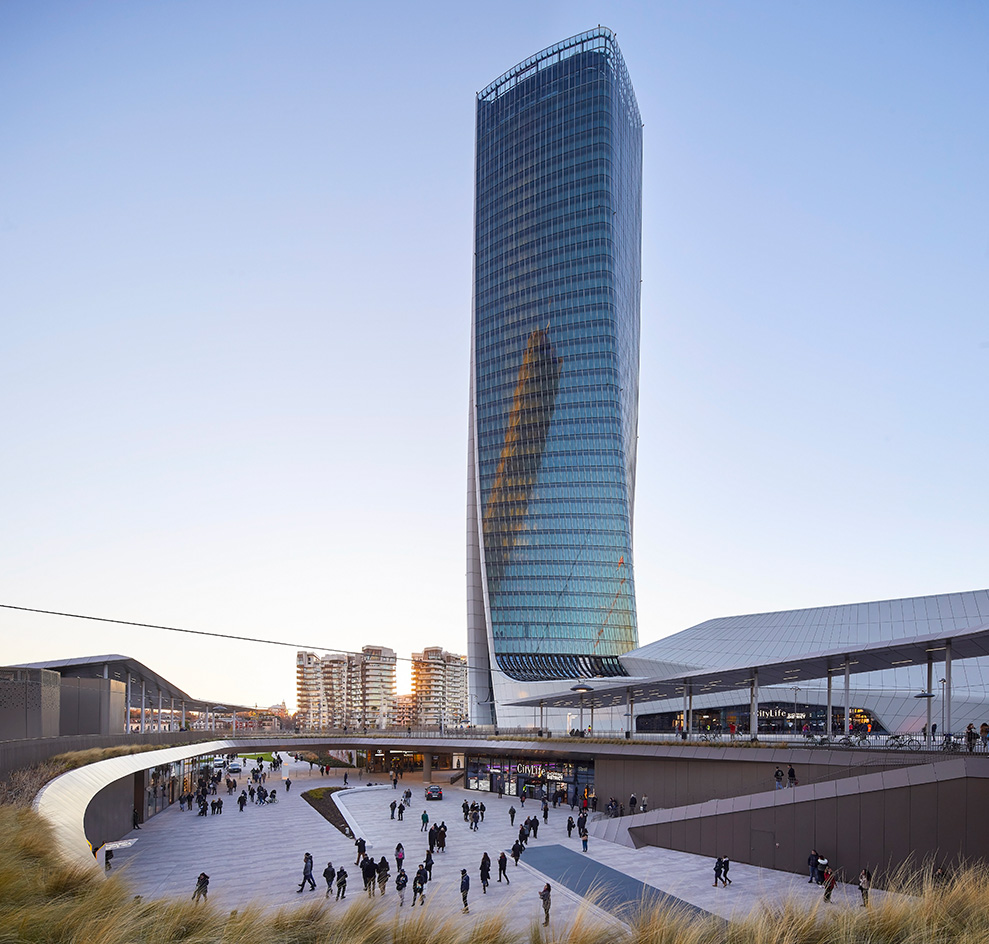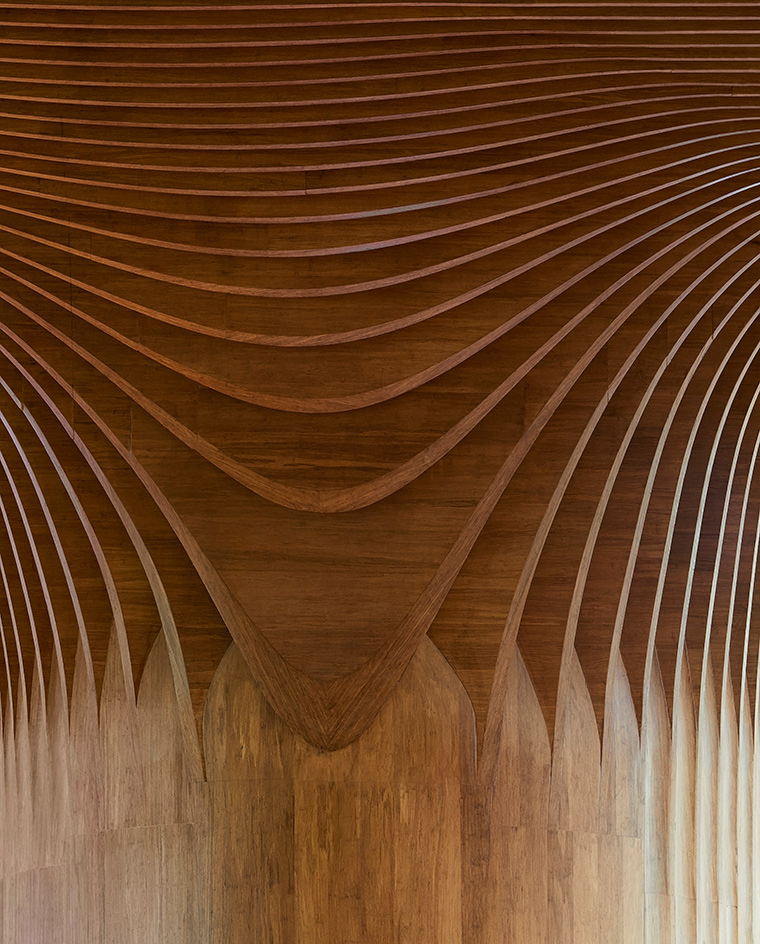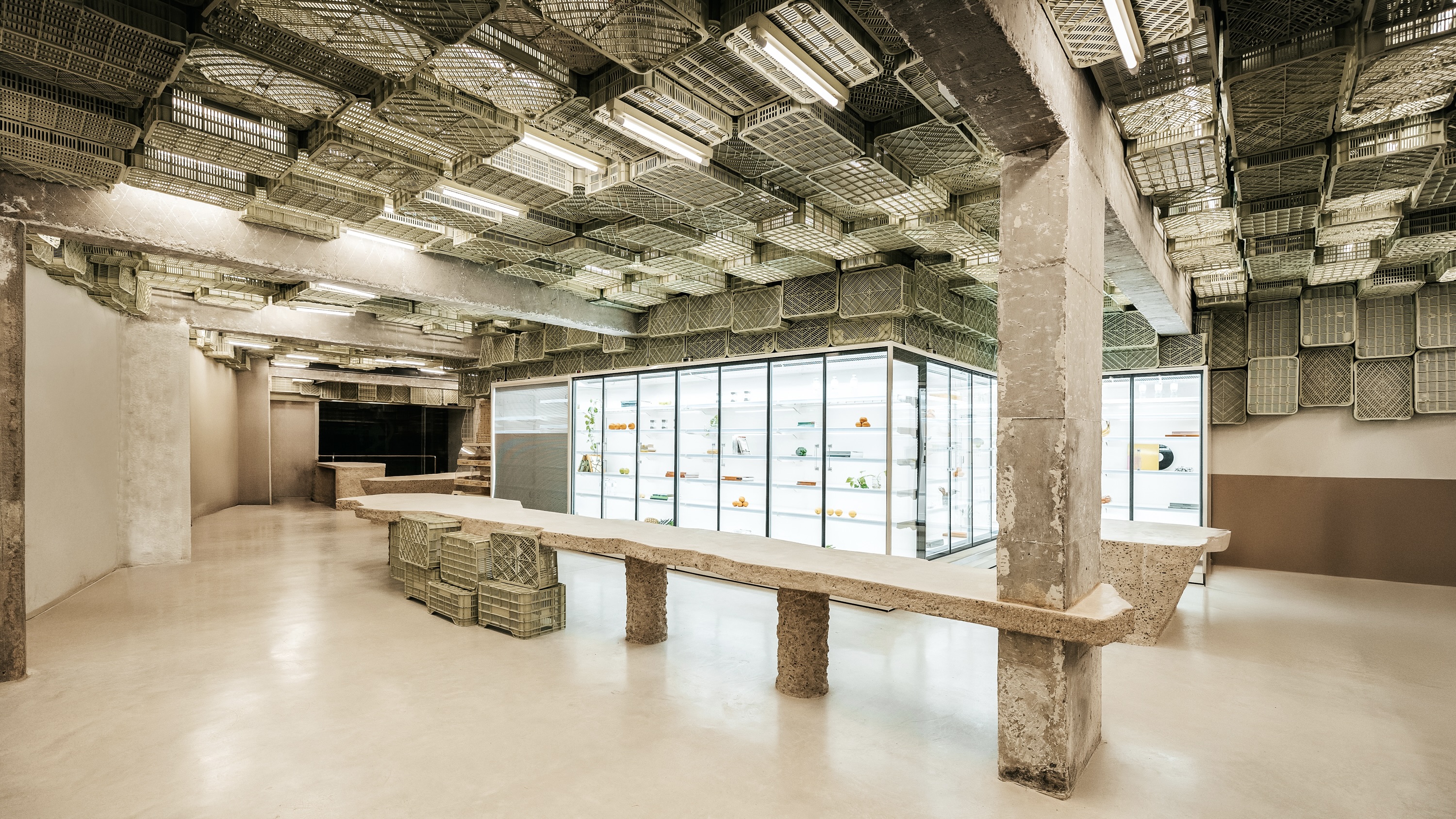Zaha Hadid Architects’ CityLife Shopping District opens in Milan

The CityLife Shopping District in Milan, designed by Zaha Hadid Architects is now open to the public. The 32,000 sq m shopping centre forms part of the CityLife development in the district surrounding the Tre Torri station on the M5 line of Milan’s metro.
The three storey shopping centre connects to the smoothly swooping Zaha Hadid Architects-designed mixed-use, 44-storey Generali Tower, set to complete in 2018 and a wider public park, central plaza and residential area spanning 90 acres. The whole CityLife complex, located at Milan’s old trade fair grounds, is one of Europe’s largest redevelopment projects.

The CityLife Shopping District and Generali Tower designed by Zaha Hadid Architects, which sit at the heart of the CityLife redevelopment project in Milan.
The defining design factor of the shopping complex is the extensive and exquisite use of bamboo – the material flows from the flooring and extends into columns that eventually reach the ceiling in one swift wave-like motion. The bamboo was curved into shape using resins under high pressure and engineered blocks of the bamboo were carved into ribs by a 5-axis CNC milling machine, then hand finished to create the totally smooth and fluid interior effect.
The dark honey-coloured bamboo swells into counters in the food halls which feature new Italian and international restaurant offerings, and brings a natural warmth to the shopping galleries containing brands such as Adidas, Levi’s, Tommy Hilfiger and Timberland.
The shopping district opens up onto the Tre Torri Piazza, designed by One Works and an open-air pedestrian shopping street designed by architect Mauro Galantino, which in turn connect to the wider area featuring architectural projects by Arata Isozaki, Daniel Libeskind, and the CityLife Milano residential complex designed by Zaha Hadid Architects and completed in 2013. The CityLife Park surrounds and connects the separate elements of the CityLife complex together through green public realm.

The layered architecture features skylights that bring plenty of light into the galleries

Bamboo is used extensively in the interiors, pictured here flowing from columns to ceiling in a smooth, organic motion

The ribbed effect was created with a 5-axis CNC milling machine and then hand finished

Bamboo was chosen by the architects for its warm aesthetic
INFORMATION
For more information, visit the Zaha Hadid Architects website
Receive our daily digest of inspiration, escapism and design stories from around the world direct to your inbox.
Harriet Thorpe is a writer, journalist and editor covering architecture, design and culture, with particular interest in sustainability, 20th-century architecture and community. After studying History of Art at the School of Oriental and African Studies (SOAS) and Journalism at City University in London, she developed her interest in architecture working at Wallpaper* magazine and today contributes to Wallpaper*, The World of Interiors and Icon magazine, amongst other titles. She is author of The Sustainable City (2022, Hoxton Mini Press), a book about sustainable architecture in London, and the Modern Cambridge Map (2023, Blue Crow Media), a map of 20th-century architecture in Cambridge, the city where she grew up.
-
 The new Tudor Ranger watches master perfectly executed simplicity
The new Tudor Ranger watches master perfectly executed simplicityThe Tudor Ranger watches look back to the 1960s for a clean and legible design
-
 This late-night hangout brings back 1970s glam to LA’s Sunset Boulevard
This late-night hangout brings back 1970s glam to LA’s Sunset BoulevardGalerie On Sunset is primed for strong drinks, shared plates, live music, and long nights
-
 How Memphis developed from an informal gathering of restless creatives into one of design's most influential movements
How Memphis developed from an informal gathering of restless creatives into one of design's most influential movementsEverything you want to know about Memphis Design, from its history to its leading figures to the pieces to know (and buy)
-
 Modernist Palazzo Mondadori’s workspace gets a playful Carlo Ratti refresh
Modernist Palazzo Mondadori’s workspace gets a playful Carlo Ratti refreshArchitect Carlo Ratti reimagines the offices in Palazzo Mondadori, the seminal work by Brazilian master Oscar Niemeyer in Milan
-
 Wang Shu and Lu Wenyu to curate the 2027 Venice Architecture Biennale
Wang Shu and Lu Wenyu to curate the 2027 Venice Architecture BiennaleChinese architects Wang Shu and Lu Wenyu have been revealed as the curators of the 2027 Venice Architecture Biennale
-
 At the Holcim Foundation Forum and its Grand Prizes, sustainability is both urgent and hopeful
At the Holcim Foundation Forum and its Grand Prizes, sustainability is both urgent and hopefulThe Holcim Foundation Forum just took place in Venice, culminating in the announcement of the organisation's Grand Prizes, the projects especially honoured among 20 previously announced winning designs
-
 Carlo Ratti reflects on his bold Venice Architecture Biennale as it closes this weekend
Carlo Ratti reflects on his bold Venice Architecture Biennale as it closes this weekendThe Venice Architecture Biennale opens with excitement and fanfare every two years; as the 2025 edition draws to a close, we take stock with its curator Carlo Ratti and ask him, what next?
-
 Spice up the weekly shop at Mallorca’s brutalist supermarket
Spice up the weekly shop at Mallorca’s brutalist supermarketIn this brutalist supermarket, through the use of raw concrete, monolithic forms and modular elements, designer Minimal Studio hints at a critique of consumer culture
-
 Step inside Casa Moncler, the brand’s sustainable and highly creative Milanese HQ
Step inside Casa Moncler, the brand’s sustainable and highly creative Milanese HQCasa Moncler opens its doors in a masterfully reimagined Milanese industrial site, blending modern minimalism and heritage, courtesy of ACPV Architects Antonio Citterio Patricia Viel
-
 Aldo Frattini Bivouac is a mountain shelter, but not as you know it
Aldo Frattini Bivouac is a mountain shelter, but not as you know itA new mountain shelter on the northern Italian pre-Alp region of Val Seriana, Aldo Frattini Bivouac is an experimental and aesthetically rich, compact piece of architecture
-
 The 2026 Winter Olympics Village is complete. Take a look inside
The 2026 Winter Olympics Village is complete. Take a look insideAhead of the 2026 Winter Olympics, taking place in Milan in February, the new Olympic Village Plaza is set to be a bustling community hub, designed by Skidmore, Owings & Merrill